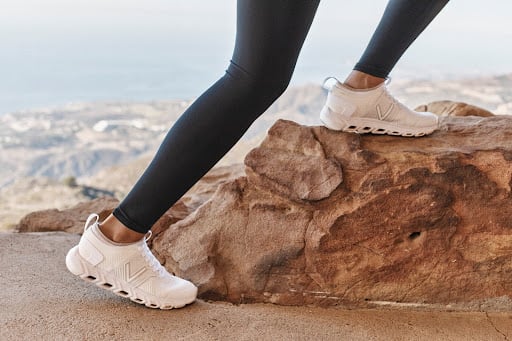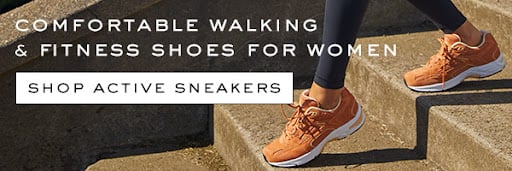As our world has entered the modern age, so many aspects of our lives have been revolutionized. Take the running shoe, for example. What started as nothing more than woven cloth has become a feat of engineering scientifically designed to make running easier than ever.
But is it possible that some advancements have overcorrected our problems?
Many running enthusiasts claim that minimal shoe support improves running technique, so you may feel conflicted between advanced and flat styles when choosing a running shoe. Fortunately, we’re here to answer the question once and for all: are flat shoes good for running?
While the answer isn’t as straightforward as some would believe, we’re ready to run headfirst into this debate confident that you’ll come out wiser (and maybe even faster) than before.
What Is Considered a Flat Shoe?
The world of athletic shoes is vast and expansive—if you’ve been inside a shoe store recently, you know exactly what we’re talking about. However, to study our subject in-depth, we must first define it. So how can you pick out a flat shoe in the crowd?
A flat shoe consists of a flat sole with virtually no arch support.1 These shoes also have no heel-to-toe drop (a measurement used to define the evenness of the foot). In addition, flat shoes typically consist of the following:
- Lightweight material
- Thin, flexible soles
- Limited padding
While we could give you a fancy-sounding scientific name like plana curre calceamentum, a flat shoe is truly just that—a flat shoe.
The Benefits of Flat Shoes for Running
The art of running has been around long before shoes even existed. In fact, barefoot running remains popular to this day among avid runners and tribes2 across the world.
This begs the question, what makes barefoot running (or running with flat shoes) so popular? Believe it or not, this type of running can actually improve your running technique (and general health) in many ways. For instance, running with minimal support can help:
- Improve your form – The cushioning in traditional shoes makes it easy for the heel to contact the ground first. However, you ideally want your midfoot3 to touch the ground first when running. Without cushioning and arch support, a flat sole allows this to occur with every step.
- Increase your foot strength – When cushions and support are removed from your shoes, your muscles have to work twice as hard. While this may make running feel more grueling at first, over time, it can contribute to increased muscular strength and elasticity in your feet, as well as increased energy in general.
- Decrease your risk of injury – Cushioned shoes can often overcorrect4 on proper form and increase your risk of injury. This is because cushioning makes it easier to lead with the heel which can result in excess pressure or overpronation. Flats challenge runners to balance their weight evenly instead of relying on the shoe to do it for them.
- Enhance your speed – Flat shoes work exceptionally well for runners looking to improve their speed. Between the lightweight nature of the shoe and the desired alignment it can provide, flats could help you break your long-held records.
To put it simply, not only can flat shoes make you feel closer to your barefoot ancestors, but they can also help strengthen your skills as a runner. We like to call that a win-win.
The Disadvantages of Flat Shoes for Running
Even though flat shoes can prove very beneficial in some aspects (as evidenced above), you may not want to run out to the shoe store (pun intended) just yet.
It’s important to note that while flat shoes have many positive qualities, they’re typically reserved for advanced runners only. Beginner runners who don’t have a comprehensive understanding of running form can more easily injure themselves when running in flat shoes.
In fact, some adverse side effects of running with flat shoes can include the following:
- Increased joint pain – While the lack of cushioning can lead to improved form down the line, many runners still need the padding of typical running shoes for protection. This is also true for those who experience foot pain and joint pain—additional shoe cushioning can help maintain a comfortable and balanced stride.
- Worsening of pre-existing conditions – Flat shoes can also harm those with affected pronation since they have no contouring in the sole. In other words, a runner needs a shoe that keeps their foot in alignment, and flat shoes cannot offer that kind of support.
- Altered gait – Flat shoes can help runners achieve a stride more suited for running, but they can sometimes negatively affect your natural gait. Depending on existing proclivities, flat shoes5 may cause individuals to keep their toes curled or strain their muscles unnaturally.
- Increased likelihood of blisters – Constantly having flat feet make complete contact with the ground can lead to toughened skin, blisters, and bleeding on the soles. The pain can fade with time, but if you’d rather avoid the inconvenience, you may want to stick with traditional padded shoes.
It’s safe to say that the answer to the question, “are flat shoes good for running?” is a bit of a mixed bag (and we’re not talking about trail mix—sorry, runners). Since there are both positives and negatives to running with flat shoes, let’s take a look at some instances when you may benefit from flat shoes.
When To Use Flat Shoes for Running
Flat shoes can prove incredibly beneficial to runners when used appropriately. This leads us to our next question, how can you know when it’s the right time to use a flat running shoe?
To put it simply, the right time will differ from runner to runner. For some, flat shoes may never be the answer. One reason for this is that transitioning to running in flat shoes can feel exhausting, challenging, and time-consuming, so it may not be ideal for the casual runner.
Before you go on a flat shoe shopping spree, we suggest you consider the following checklist to see if flat shoes are right for you.
Generally speaking, you may want to try flat shoes for running if:
- You’re an advanced runner looking for a challenge
- You’re after a more biologically sound stride
- Your running shoes have started hurting your feet
- You’ve consulted a podiatrist and know that you don’t need additional arch support
- You feel confident in your proper running form
If one or more of these statements rings true, it may be time to make the switch to a flat running shoe.
How To Use Flat Shoes for Running
Once you’ve decided a flat running shoe is right for you, you may want to lace up your new shoes and pound the pavement immediately. However, we must stress the importance of a slow transition from traditional shoes to flat shoes.
This is because your body needs time to adapt to the new type of shoe. Otherwise, you’ll risk injury before you can even enjoy the benefits.
To that end, it’s best to stick with these guidelines during your transition phase:
- Start slow – You have to walk before you can run, right? Well, the same advice applies here. If you have a new pair of flat shoes, you need to start with the basics. Begin the transition by wearing your flat shoes when running errands, like going to the grocery store, or walking the dog. From there, you can start walking short distances (the key word here being short). Avoid the urge to push your limits.
- Increase your mileage gradually – Slowly but surely, you can add mileage to your walks. However, it’s important to only increase your mileage on the days you feel comfortable the entire time. Eventually, you can transition from long walks to short jogs. Keep an even pace until you can finally work up to running again.
- Give yourself plenty of time – Turning your transition time into crunch time is not wise. For example, you don’t want to buy flat shoes for a half-marathon next week. Generally speaking, you should give yourself a few months to fully acclimate to your new shoes.
Think of your new flat shoes as a form of endurance training. If you stick to the program and stay consistent, you may run better than ever after a few months. Just stay positive and remember that, in this instance, it is not a race.
Flat Shoe Alternatives
By now, you may know whether or not flat shoes reside in your future. And if they don’t—not to worry! While flat shoes may not suit every runner, you can still find some of their beneficial aspects in other types of shoes.
When browsing athletic shoes, you can keep your eyes peeled for the following:
- A low heel-to-toe drop
- A lightweight feel
- Impressive flexibility
By opting for just a few minor tweaks, you can reap many of the same benefits of flat shoes without sacrificing comfort.
Rediscover Your Active Lifestyle with Vionic Shoes
It’s easy to get swept up in all the advancements of the world around us. That’s why it’s essential to do your own investigating every once in a while. As you grow your understanding of the different parts of a sneaker or learn additional common shoe terminology, you may discover amazing things, like how flat shoes can prove incredibly beneficial when worn under the right circumstances.
You may even discover that high-quality, supportive athletic shoes are more than just a theory. In fact, at Vionic, they’re our reality.
That’s because we build Vio-Motion Support into every single one of our shoes, from athletic footwear to stylish sandals. This advanced technology prioritizes stability, arch support, and flexibility so that your feet can stay comfy and healthy no matter how far you’re going.
Sources:
- Mc Kay, Sarah. “Our Podiatrist Answers Are Flat Shoes Bad For Your Feet?” Foot Centre Group. 4 May, 2021. https://www.footcentregroup.com.au/are-flat-shoes-bad-for-your-feet/
- “The Barefoot Running Debate.” Chris McDougall. https://www.chrismcdougall.com/born-to-run/the-barefoot-running-debate/
- Jafary, Hamed. “Is Barefoot Running Better? Or Are You Running Towards Injury?” Foot and Ankle Institute. Updated 2 February, 2023. https://www.footankleinstitute.com/blog/barefoot-running-pros-cons/
- Kulmala, Juha-Pekka et al. “Running in highly cushioned shoes increases leg stiffness and amplifies impact loading.” Scientific reports vol. 8,1 17496. 30 Nov. 2018, doi:10.1038/s41598-018-35980-6
- “How Do Flat Shoes Cause Spine Pain?” The Spine Institute. https://www.laspine.com/flat-shoes-cause-spine-pain/



Leave a Reply